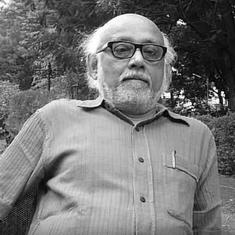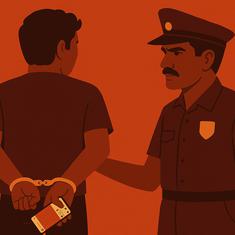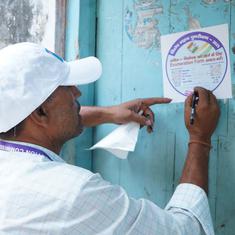Shortly after I arrived in Patiala in the last week of May, I received news of a young farmer who had died by suicide. He was the neighbour of Mandeep Kaur, an organiser for the Bharatiya Kisan Union (Ekta Ugrahan), whom I was going to meet. Barely a week later, I learnt of another suicide, this time an agricultural labourer.
Data from the National Crime Records Bureau says that 157 farmers in Punjab died by suicide in 2023. Punjab ranked fifth among states that year for farmer suicides. However, farm unions estimate the number to be higher and have started collecting their own data.
In my travels through Punjab during the summer of the 2024 general election, my queries about the number of suicides in the state were met with an almost instant explanation: “tension”. But underlying that tension, experts say, is an agrarian crisis that has disrupted lives and livelihoods in Punjab.

I was afforded an insight into the tumult as I visited Patiala, Sangrur, Mansa and Khadoor Sahib and spoke to residents about their challenges, hopes and dreams.
For rural women, the crisis is not a distant abstraction. As Punjab’s economic and agricultural distress drives some male breadwinners to die by suicide, their wives are left to fight a lonely battle, labouring to repay debt and raise their children.

Punjab in distress
In my conversations with women, the threat of losing a loved one to debt was real for many. The question of how they would manage after that hung in the air. Women themselves are saddled with debt: according to a survey by Punjabi University conducted between 2022-’24, 60% of the women in rural Punjab are living in debt.
The crisis is most apparent in Ralla village of Mansa district in Punjab’s cotton belt. Of 16,606 cases of suicide by farmers and agricultural labourers in Punjab between 2000 to 2015, the highest number were in Mansa – 3,388 cases, according to a survey by Punjab Agriculture University in 2018.
That is where I met Veerpal Kaur, 45, who has seen agrarian distress and debt claim three men in her family. Her father, a cotton farmer with a one-acre plot, had died by suicide as he was unable to repay loans after the crop failed in 1995. Veerpal Kaur, then 15, quit school and took up daily wage labour selling bangles, picking cotton and doing domestic work.
Her husband’s father – a cotton farmer with one-and-a half-acres of land – had died by suicide in 1990, before Kaur got married. Her husband too struggled with debt and died by suicide in 2003, four years after she got married.
Kaur then became an activist with the Kisan Mazdoor Khudkhushi Peedit Parivar Committee, which advocates for the rights of farmer and labourer families whose members died by suicide. The committee works to secure compensation as per the 2015 Punjab government policy to pay Rs 3 lakh to agrarian families who have suffered suicide deaths.
During our meeting, Veerpal Kaur was a whirl of activity. Her phone was always ringing, her hands constantly shuffling legal documents or hand-written records of cases of suicide in her village. “It is only by putting our demands forward and struggling on our own behalf that anything can change,” she said.
Researchers like Ranjana Padhi contend that the current crisis has its roots in the Green Revolution in Punjab in the 1960s. High-yielding seeds increased food production, but required expensive mechanisation, fertilisers and pesticide that fundamentally changed the state’s agrarian economy.
According to a survey conducted in 2020, the cost of farming in Punjab is higher than in states such as Karnataka, Madhya Pradesh and Bihar. But there has been only a minor increase in the minimum support price at which the government buys specific crops from farmers. This is meant to act as a safety net if the market price falls below the minimum support price. “Consequently, the farming sector of the state is heavily indebted,” explains the state’s suicide policy.
Agricultural labourers have also experienced an economic squeeze. earning incomes that are not adequate for them to survive on. Rural communities in the state face other challenges that drain their resources: inflation, poor public health facilities and expensive private healthcare and education.

Forgotten political promises
Suicide relief for agrarian families has been used as a political tool by consecutive governments, writes Inderjeet Singh Jaijee, author of Debt and Death in Rural India, in a 2016 article on the revised compensation scheme. Between 2001 and 2022, when the Congress and Shiromani Akali Dal-led governments ruled Punjab in turns, launched schemes and policies to address farmer suicide but these have been inadequate.
Veerpal Kaur’s own situation exemplified the problem: when she decided to contest the general elections as an independent candidate in 2019, her manifesto listed her monthly income as Rs 2,800 and family debt at Rs 8 lakh. She had no hope of winning against Shiromani Akali Dal stalwart Harsimrat Kaur Badal, who has represented Bathinda constituency since 2009. But she had hoped to shed light on lives of families affected by suicide deaths.
Ironically, during the general elections in 2024, the Aam Aadmi Party used a photograph of Veerpal Kaur, without her permission, in a poster claiming that women in Punjab are earning sums of Rs 20,000. Veerpal Kaur, as well as other community organisers, claim that since the Aam Aadmi Party came to power in Punjab in March 2022, applications for the compensation scheme are not even being accepted.
Walking through Ralla Pind, Veerpal Kaur gestured around her at the homes of families that had been struck by tragedy.

She introduced me to several women who were eligible for the compensation scheme, but who said that they had not been allowed to even submit their paperwork.
Manpreet Kaur, a 47-year-old labour organiser with the International Democratic Platform, pointed out that women earn less than men and have limited employment options. “In conditions in which the man has been unable to run the house, what will his widowed wife be able to do?” she said.
Healthcare and debt
Kalwinder Kaur, 40, comes from a land-owning family of marginal farmers in Mansa. After her husband developed blood cancer, the family took a loan of Rs 5 lakh from a public bank and borrowed from village moneylenders to finance his treatment. The half-acre of land that they sold was not enough to repay his debt. Fearing that he would not recover from his illness, he died after drinking “sprey”, the local term for pesticide.
Kalwinder Kaur now works as a tailor to repay the loan and support her four children, earning Rs 2,000-Rs 4,000 a month.
She and her family were among the many small and marginal farmers I met who had been forced to sell their land. Seventy-seven per cent of suicides were by small and marginal farmers who cultivated less than two hectares of land, said according to a study published in 2022.
The heavy mechanisation due to the Green Revolution, coupled with the absence of adequate state investment in creating alternate livelihoods, has resulted in fewer job opportunities and lower wages. In 2022-’23, unemployment in Punjab was 6.1%, almost twice the national average of 3.2%.


Karamjit Kaur, 42, whose husband died by suicide in 2021, said the family had taken a loan of Rs 3 lakh from moneylenders lakh in 2018 to pay for her eye operation. During the Covid-19 lockdown, work stopped and it became impossible to repay the debt. Her husband, like many others, died by suicide by consuming “sulphas”, the popular name for the agricultural fumigant aluminium phosphide.
She has not received compensation from the state and neither have central government schemes come through for this mother of four. Corruption, say community organisers, often prevents beneficiaries from receiving their dues.
Karamjit Kaur used to clear cow dung from farms. Now older and unable to work on the fields, she cleans homes, for which she earns Rs 1,000 a month. She receives Rs 1,500 as pension for widows from the state government.
When the Aam Aadmi Party came to power in the state in March 2022, it had promised Rs 1,000 per month for women. But not a single woman I met across the four districts I travelled to said that she had received the amount, or knew anyone who did.
Shireen, in her early 40s and an activist with Lok Morcha Punjab, which creates awareness on the rights of farmers and workers, said that changes in land ownership could help relieve some of the state’s problems. “Until the poor, the workers [and] poor farmers get more land, agriculture will be in crisis,” she said.
Ramanjyot Kaur, in her mid-20s and an organiser with the Democratic MGNREGA Front in Patiala, said that inadequate employment is crippling the state.

“People go outside and do labour work only because here one doesn’t get the value of one’s work,” said Ramanjyot Kaur. “If people can get employment then the problem of drugs will also abate. These are all linked.”

A 2024 study by Punjab Agricultural University found that emigration has steadily increased in rural Punjab and the trend is pronounced from 2016. It said 13.34% of respondents had at least one family member who had migrated to another country. Three-fourth of the respondents said that unemployment, corruption and low income were the motivating factors. They sold gold and homes or took loans to go abroad.

At a rally organised by the Bharatiya Kisan Union (Ekta Ugrahan) in Barnala, I met Karamjit Kaur, a farm worker from Bathinda. At 42, she has seen many elections. When asked which party she places her faith in, she said that her faith is in her union. Her words reflected the apathy of the state machinery towards workers in Punjab, especially women.
“We educate our children with great difficulty but they do not get any jobs,” said Karamjit Kaur. “We do whatever we can – we clean, we sweep, we swab, we clear garbage. Our daughters are also educated but they get no work.”
All illustrations by Vidyun Sabhaney.
Vidyun Sabhaney is a comics creator based in New Delhi. Most recently, she co-authored the graphic novel Food & Farming: A Journey Through India in Comics. She has also edited comics anthologies, including the First Hand books. Her Instagram handle is @vidyunsabhaney.










